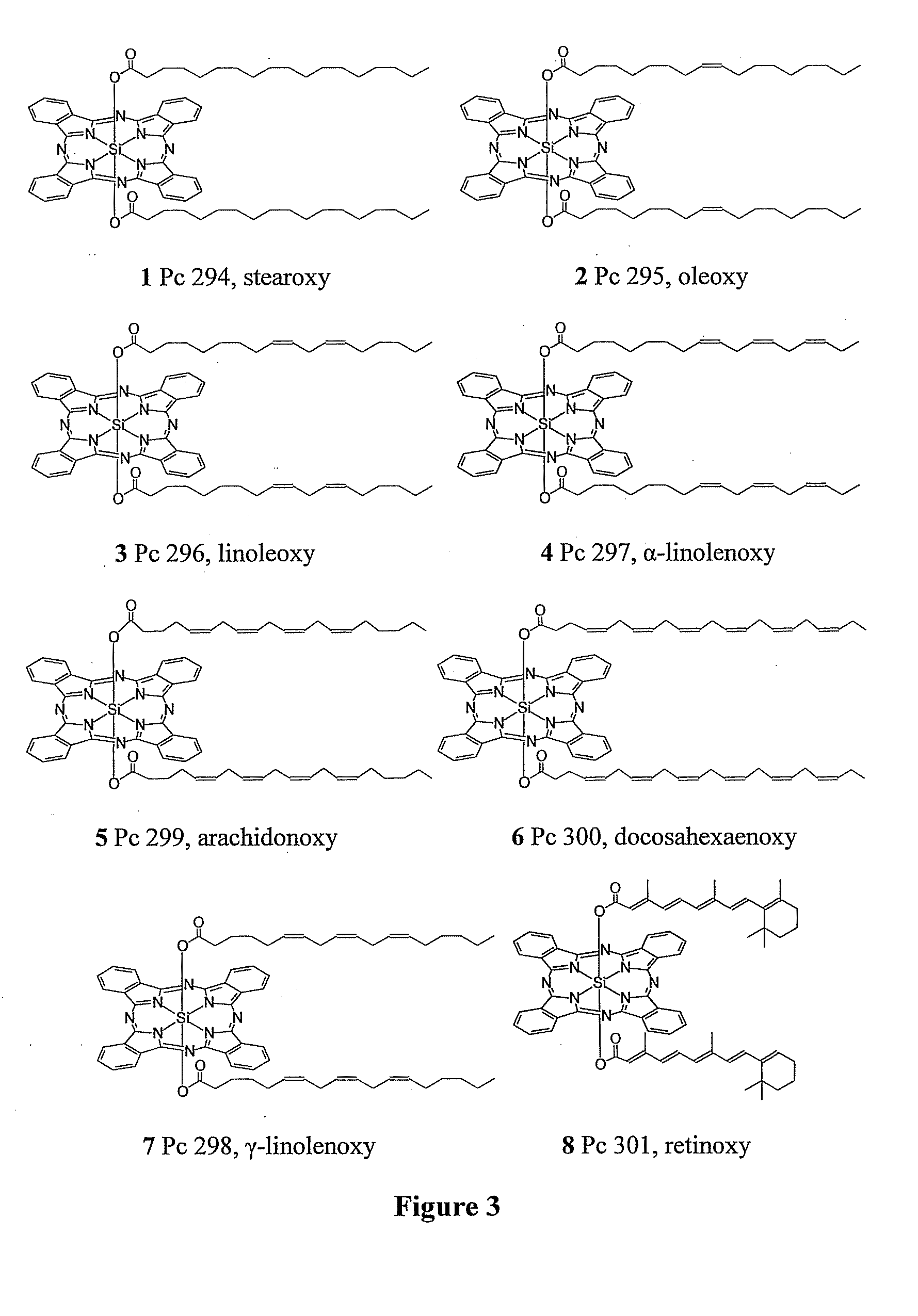Photodynamic therapy with phthalocyanines and radical sources
a technology of applied in the field of photodynamic therapy with phthalocyanine and radical source, can solve the problem that the cell destruction will not be compl
- Summary
- Abstract
- Description
- Claims
- Application Information
AI Technical Summary
Benefits of technology
Problems solved by technology
Method used
Image
Examples
example 1
Photostability of Al and Si Phthalocyanines to Free Radicals
[0076]With the previous work showing that aluminum and silicon phthalocyanines are stable to 1O2, attention naturally turns to the resistance of these phthalocyanines to free radicals. As a source of free radicals, the reaction of polyunsaturated alkenes with 1O2 (from irradiation of the phthalocyanines) was chosen. Various polyalkenes were considered. Ultimately squalene was chosen because it reacts readily with singlet oxygen to give free radicals and is commercially available. In addition, it is easily soluble in toluene and has an uncomplicated structure (no functional groups other than double bonds).
[0077]For all of the photodecomposition experiments, a slide projector (EKTAGRAPHIC III E, Kodak, Japan) equipped with a tungsten-halogen lamp (300 W, EIKO, Shawnee, Kans.) powered to operate at 3350 K, and a custom-made polypropylene cuvette holder were used. The distance between the cuvette face and the lamp filament was ...
example 2
Influence of the Structure of the Axial Ligands on the Photostability of Silicon Phthalocyanines in Presence of Squalene
[0085]The decomposition of silicon phthalocyanines can be induced by the combination of squalene, air and light, and the decomposition rate of these phthalocyanines appears to be affected by the nature of the axial ligands. To investigate this axial-ligand effect in more detail, the photostability of a series of silicon phthalocyanines with various axial ligands was studied in the presence of squalene and air. The results show that the structure of the ligands has considerable influence on the stability of these phthalocyanines.
[0086]The data provided in Table 2 on the five bis-capped silicon phthalocyanines SiPc[OSi(CH2)nCH3)3]2, where n is 0, 1, 2, 5 and 7 show that their stability increases with increasing size of the axial ligands up to n=2. The trend for the three lighter members of the series is attributed to the greater steric protection provided by larger l...
example 3
Influence of Replacement of Squalene by Other Alkenes
[0089]Since previous work showed that free radicals generated by the attack of 1O2 on squalene can induce the decomposition of phthalocyanines, it was of interest to investigate the ability of alkenes in general to cause the photodecomposition of phthalocynines as a function of their structure. This led to studies with 1,4-cyclohexadiene, 1,3-cyclooctadiene, 1,5-cyclooctadiene, linoleic acid, geraniol and farnesol, shown in FIG. 2.
[0090]The results of these studies, provided in Table 3, show that the six new alkenes all decrease the photostability of Pc 4, with geraniol and farnesol being the most effective. These latter two are analogues of squalene but only have two or three 2-methyl-2-butene units rather than the six that squalene has. However, although they have fewer double bonds, they show greater effectiveness. This effectiveness appears to be related to the presence of their allylic OH groups. Supporting this conclusion is...
PUM
| Property | Measurement | Unit |
|---|---|---|
| structure | aaaaa | aaaaa |
| diamagnetic | aaaaa | aaaaa |
| composition | aaaaa | aaaaa |
Abstract
Description
Claims
Application Information
 Login to View More
Login to View More - R&D
- Intellectual Property
- Life Sciences
- Materials
- Tech Scout
- Unparalleled Data Quality
- Higher Quality Content
- 60% Fewer Hallucinations
Browse by: Latest US Patents, China's latest patents, Technical Efficacy Thesaurus, Application Domain, Technology Topic, Popular Technical Reports.
© 2025 PatSnap. All rights reserved.Legal|Privacy policy|Modern Slavery Act Transparency Statement|Sitemap|About US| Contact US: help@patsnap.com



